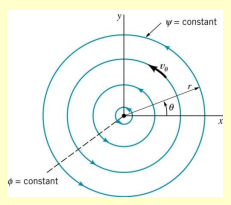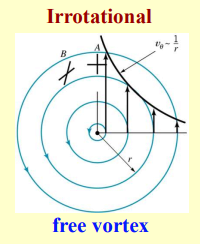A vortex represents a circular flow around a circular axis. There are two primary types of vortex flows: irrotational (free vortex) and rotational (forced vortex).

Irrotational (Free)
In an irrotational vortex, the fluid particles move in circular paths around a center with no internal rotation (like water swirling in a drain).

The tangential velocity decreases with radius:
where is a constant representing the strength of the vortex.
The radial velocity is simply zero:
The velocity potential can be solved to be:
- Equipotential lines are radial lines because varies with the angle .
The stream function can be found to be
- Streamlines are concentric circles around the origin.
Rotational (Forced)
In a forced vortex, the fluid particles rotate like a solid body; the velocity increases linearly with radius.
This type of motion is different from the free vortex because it requires a continuous input of energy to maintain the rotation.

Circulation
Circulation represents the line integral of the tangential component of velocity around a closed path:
For irrotational flows, if there are no singularities:
However, if a singularity like a point vortex exists, the circulation is non-zero and is:
The velocity potential and stream function expressions become:
- The streamlines are circular around the center, and the flow remains irrotational everywhere except at the singularity.